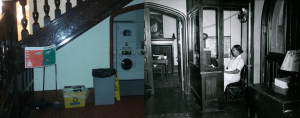
Under the Pem West Staircase: 2016 vs. the 1950s/60s. A receptionist once used the “bells desk” on the right to admit visitors to the dorm, or to inform students that a guest had arrived.
Before consulting Tripod in order to write my survey reflection, I hadn’t realized just how many places on campus have been completely changed or repurposed over the years. At some point in Bryn Mawr’s history, for example, the dining hall in Rockefeller became an architecture studio, and a soda machine now stands where a receptionist used to sit in Pembroke West (see above). We see and interact with these spaces every day as students, just as students before us had done for over a century. However, I at least was never fully aware of how the dorms functioned differently for past students, especially since traces of this history seem to have been removed as the spaces were updated.
My proposal had originally centered on the recreation of old dorm rooms using the furniture items stored in Special Collections, many of which resemble those seen in photos from the early 1900s. This could still be plausible on a smaller scale, but there are other historic spaces that cannot be easily reconstructed, such as the bells desk mentioned above. In these areas (as well as in the recreated rooms), photographs would be displayed in a sort of visual timeline, showing how the function of the space changed with the passing decades. Many photos on Tripod depict students and housekeepers living and working in the dorms, and would thus add a personal dimension to the history of each space. The dorm room exhibits would be set up during the school year on occupied halls, so that students in neighboring rooms could interact directly with the history of the building in which they were living. By situating displays and photographic timelines around campus, I would hope to make the history of these spaces more visible, fostering a connection between those who once lived in them and those who live in them today.
